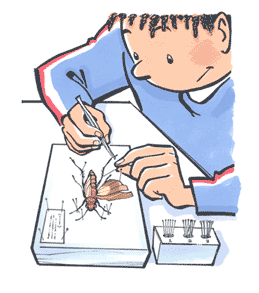With these articles, I want to share with you my motivations and my knowledge on the creation of an entomological collection and explain its objective .
Why make an entomological collection?
A collection of insects can have several objectives like aesthetics, to possess rarities, to constitute a diversity of species and individuals, the financial profit or still a scientific interest. For my part, I opted for the latter option.
I have always had the pleasure of observing insects in nature, raising them and understanding their biology. It is thus in a logical continuation that the idea of collecting them appeared. In the beginning, it was a matter of capturing insects and putting them in pots without real technique and purpose. Then, the desire to constitute a collection in a scientific process was very quickly inscribed in me. Over the years, I have acquired the techniques, skills and methodology necessary to successfully complete this collection.
My first motivation to realize a collection is to go in search of new species of insects, to discover new biotopes and ecosystems. When I discover insects that I meet for the first time, it sharpens my curiosity and many questions come to me: What is it? What is its biology? Is it a common, rare species, why? What is its ecology? It is not a question of catching a large number of insects, one or two of each species is enough. For some, it seems paradoxical for an insect lover to kill them. My samples are totally negligible on insect populations. Think of the amount that are killed just by passing cars and using insecticides!
Then, what is exciting is determining new species. This consists of finding their name and place in the classification and then integrating them into the collection. For that, I use specialized books, websites and forums of enthusiasts (to know more, follow this link). Determination requires patience, in-depth knowledge of the morphology and different anatomical elements of insects. Given the incredible diversity in species, genera and families, finding a name for a specimen can sometimes take a long time. Fortunately, with computers and the Internet, it is possible to exchange information, receive advice and share knowledge. It is a kind of survey game, where there is the satisfaction of arriving at the name.
Finally, the goal is to scientifically value the data collected by the capture of each species. Indeed, when I capture new specimens, I associate the place of capture, the date and his name (see this article). I transmit this data to regional and national entomological inventory projects on insect distribution. These inventories are used for mapping studies, Atlas creation and impact studies. The objective is to contribute to a better knowledge of the entomofauna (insect diversity) on our territory and to participate in programs to preserve the environment and its biodiversity.
In this perspective, I also participate in inventories conducted by associations (Charente-Nature and OPIE), public bodies (Inventaire National du Patrimoine Naturel du Muséum National d’Histoire Naturelle de Paris) and private bodies. Most of the time, these inventories do not require collecting specimens, but I use these moments to complete my collection and integrate data. For the INRA, I carried out a work of modernization and valorization of their entomological collection made up of thousands of specimens coming from more than 80 years of sampling throughout France and the world (to know more: ici).
I am, of course, at your disposal for any questions, requests for advice, tips and/or expertise. Do not hesitate to contact me here. Looking forward to reading and helping you!


